Whether you're a business optimizing delivery routes or a traveler planning a road trip, these multi-stop route planners can save time, reduce fuel costs, and simplify navigation. Each tool offers unique features tailored to specific needs:
- RoadWarrior Flex: Advanced route optimization and real-time traffic updates for field teams.
- FarEye: AI-powered logistics management for large enterprises.
- Roadtrippers: Combines route planning with travel discovery for road trips.
- Badger Maps: Ideal for field sales teams, reducing drive time by 20%.
- Trucker Path: Designed for truck drivers with truck-specific routing and data.
- Furkot: Simple trip planning with export options for navigation apps.
- Apple Maps: Free, user-friendly tool with up to 15 stops.
- Routific: AI-driven logistics for delivery businesses with time window management.
- Google Maps: Free and reliable, but limited to 10 stops.
- GTFO.co: A directory to find the best travel and navigation resources.
Quick Comparison
| Tool | Best For | Key Features | Limitations |
|---|---|---|---|
| RoadWarrior Flex | Field Teams | Real-time updates, route sharing | May not suit large enterprises |
| FarEye | Large Enterprises | AI-driven logistics, global support | Custom pricing, complex setup |
| Roadtrippers | Travelers | Discover stops, offline maps | Overwhelming for basic navigation |
| Badger Maps | Field Sales Teams | Team coordination, territory tracking | Business-focused, not for casual use |
| Trucker Path | Truck Drivers | Truck-specific data, fleet management | Limited to trucking industry |
| Furkot | Travelers, Small Teams | Simple trip planning, export options | No real-time traffic updates |
| Apple Maps | Casual Users, Small Biz | Free, up to 15 stops | Lacks advanced features |
| Routific | Delivery Businesses | AI optimization, real-time adjustments | Pricing based on usage |
| Google Maps | Casual Users, Small Biz | Free, 10 stops, real-time traffic | No advanced logistics tools |
| GTFO.co | Resource Discovery | Curated travel tools directory | Not a direct route planner |
These tools cater to diverse needs, from casual users to enterprises. Choose based on your requirements: advanced logistics, travel discovery, or simple navigation. Let’s explore their features in detail.
What is Multi-Stop Route Planning?
Multi-stop route planning is all about finding the best way to visit multiple destinations in one trip. By 2025, this technology has become a game-changer for businesses and individuals, especially in logistics and delivery services, where well-planned routes directly affect efficiency and customer satisfaction.
Here’s how it works, broken down into key components:
| Component | Purpose | Impact |
|---|---|---|
| Route Optimization | Finds the best stop sequence | Cuts travel distance by up to 20% |
| Real-time Traffic Integration | Accounts for current conditions | Reduces delays and improves ETAs |
| Resource Management | Balances driver workload | Boosts efficiency by 15-25% |
| Time Window Management | Enhances scheduling accuracy | Ensures on-time arrivals |
For businesses, this kind of planning is essential. Logistics companies rely on it to streamline deliveries, keep customers happy, and cut costs. Travelers also use it to pack in more sightseeing while spending less time on the road.
Modern tools for multi-stop route planning are powered by advanced algorithms that factor in:
- Real-time traffic updates
- Delivery time windows
- Driver schedules and mandatory breaks
- Special delivery instructions
These systems often integrate with inventory tracking and fleet management software, offering a complete solution for operations. The benefits are clear - lower fuel costs, fewer miles driven, and reduced emissions, which not only save money but also support eco-friendly practices.
Knowing what these tools can do is key to choosing the right one for your needs. Next, we’ll dive into the must-have features of an effective route planner.
Features to Look for in a Route Planner
Knowing what to look for in a multi-stop route planner can make all the difference when choosing the right tool for your business. Here are the key features that set top-tier route planners apart in 2025:
| Feature Category | Key Capabilities | Business Impact |
|---|---|---|
| Route Optimization | Stop sequence optimization, Alternative routes | Cuts travel distance by 20% |
| Real-time Updates | Live traffic data, ETA adjustments | Boosts delivery accuracy |
| Customization | Vehicle types, Time windows, Route preferences | Improves operational flexibility |
| Integration | CRM systems, Fleet management, Navigation apps | Simplifies workflows |
Advanced Route Optimization
Using advanced algorithms, these tools arrange stops in the most efficient order, saving time and fuel. For example, RoadWarrior Flex is known for its highly effective route planning capabilities [1].
Real-Time Traffic Integration
The best planners use live traffic data to adjust routes on the fly, helping teams stick to their schedules even during unexpected delays. This feature is especially useful for delivery operations with strict deadlines [1].
Customization Options
Customizable settings like time windows, vehicle restrictions, and route preferences allow businesses to tailor routes to their specific needs. MapQuest, for instance, offers features like toll avoidance and highway preferences, making it a versatile choice [2].
Sharing and Collaboration
Top tools make it simple to share routes with team members, a must-have for managing complex schedules efficiently [1].
Integration Capabilities
Seamless integration with other systems ensures smoother operations. Some examples include:
- CRM systems for better customer management
- Fleet management software for tracking and optimizing vehicles
- Navigation apps for real-time guidance
- Inventory systems to align deliveries with stock availability
Flexible Pricing Models
For businesses with varying route demands, pricing flexibility can be a game-changer. MyRouteOnline offers an address-based pricing model, catering to businesses with fluctuating needs [3].
Badger Maps users have reported saving up to 8 hours each week and cutting drive time by 20% [4]. With these features in mind, you’re better equipped to assess which route planner fits your unique requirements.
1. RoadWarrior Flex
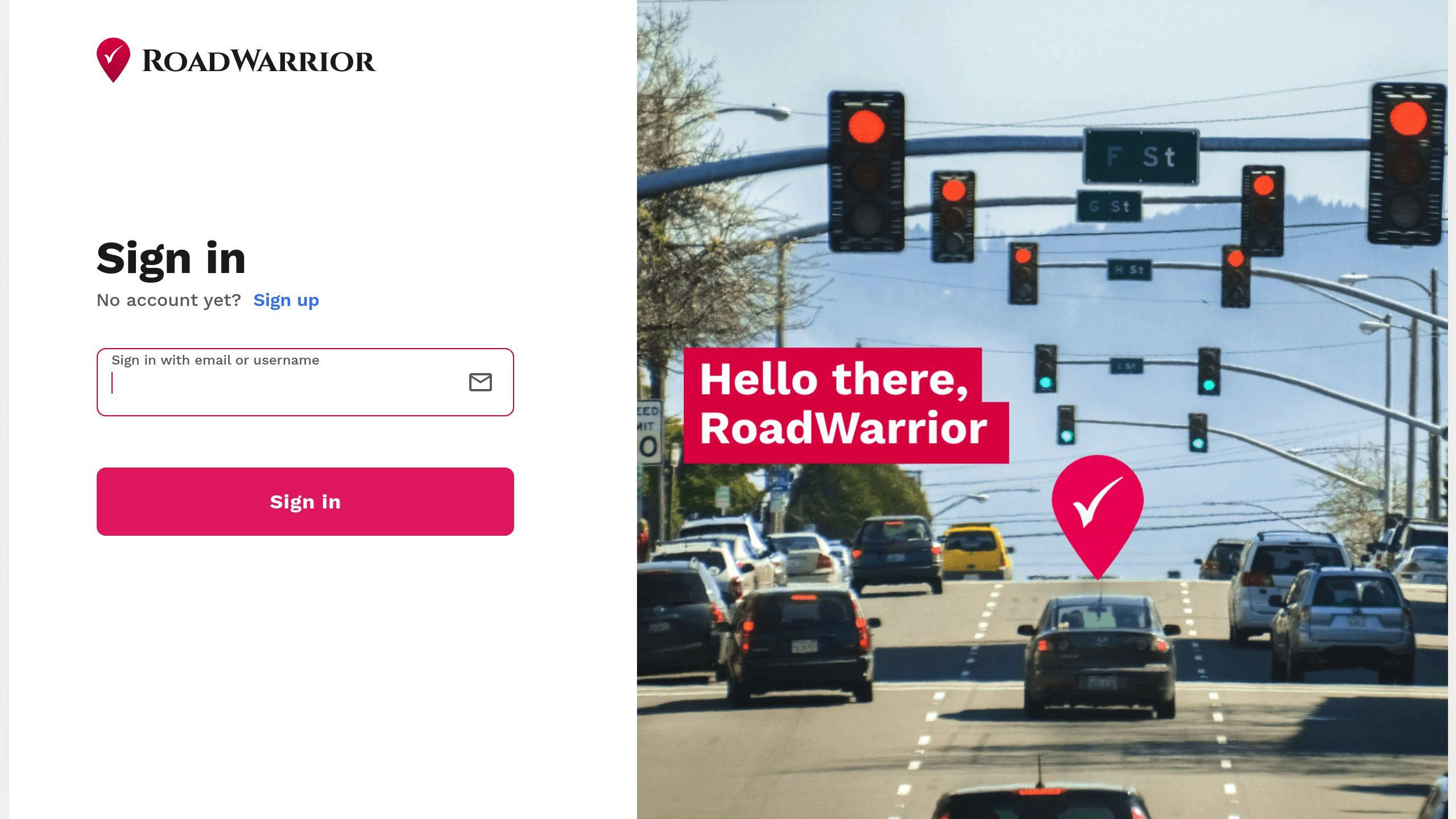
RoadWarrior Flex is a route optimization tool designed for businesses that handle multi-stop routes. It focuses on three main features that benefit field service teams and delivery operations.
| Core Capability | Description | Business Value |
|---|---|---|
| Route Intelligence | Advanced sequencing algorithms | Reduces total travel time and distance |
| Traffic Management | Real-time congestion tracking | Avoids delays and keeps schedules intact |
| Team Coordination | Route sharing and collaboration | Enhances team communication and workflow |
The tool recalculates routes in real time to adapt to changes like traffic updates or new stops [1]. This makes it ideal for businesses with flexible or evolving route demands.
Users can customize routes based on specific needs, including:
- Service duration expectations
- Custom delivery requirements
- Specialized routing preferences
Its collaborative features allow teams to share routes instantly, ensuring everyone stays on the same page [1]. This is especially useful for industries like field sales, services, and delivery operations, where efficiency is crucial.
The platform is user-friendly, catering to teams with varying technical skills. It combines powerful optimization with an easy-to-navigate interface. Real-time traffic updates help ensure timely deliveries and services [1].
While RoadWarrior Flex is excellent for dynamic route optimization, tools like FarEye may better suit businesses with unique logistics challenges.
2. FarEye
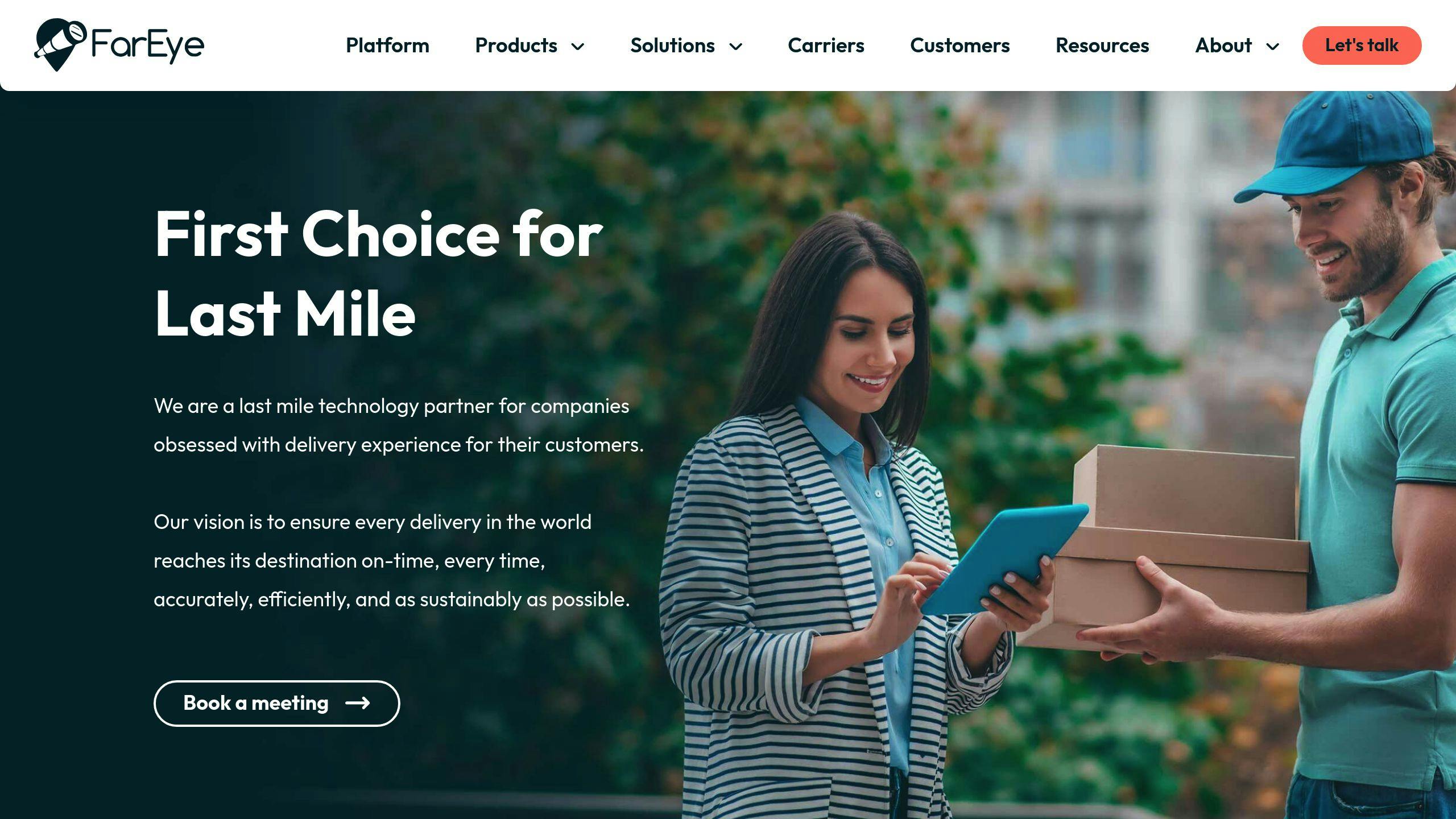
FarEye is designed for enterprises tackling global logistics challenges. Unlike RoadWarrior Flex, which is tailored for smaller teams, FarEye specializes in large-scale, enterprise-grade logistics management. It uses AI and machine learning to optimize routes and streamline operations for massive delivery networks.
| Feature Category | Capabilities | Business Impact |
|---|---|---|
| Route Intelligence | AI-driven optimization, real-time traffic updates | Cuts delivery times and lowers fuel costs |
| Operational Control | Multi-language and currency support | Facilitates global operations |
| System Integration | Connects with ERP, CRM, and TMS platforms | Ensures seamless data sharing |
FarEye’s AI adjusts routes dynamically based on factors like traffic, weather, and road closures, ensuring continuous optimization for large fleets. Managers can oversee operations through a web dashboard, while drivers receive real-time updates via the mobile app, keeping everyone aligned.
Its ability to integrate with ERP, CRM, and TMS systems allows businesses to unify logistics workflows. Combined with support for multiple languages and currencies, FarEye is particularly suited for industries like retail, e-commerce, and third-party logistics that operate across borders.
One drawback is the custom pricing model, which might not appeal to smaller businesses needing quick deployment. However, for enterprises managing intricate delivery networks, FarEye’s advanced features and tailored implementation make it a strong choice.
Looking for a tool that blends route planning with travel inspiration? Keep reading to discover the next option.
3. Roadtrippers
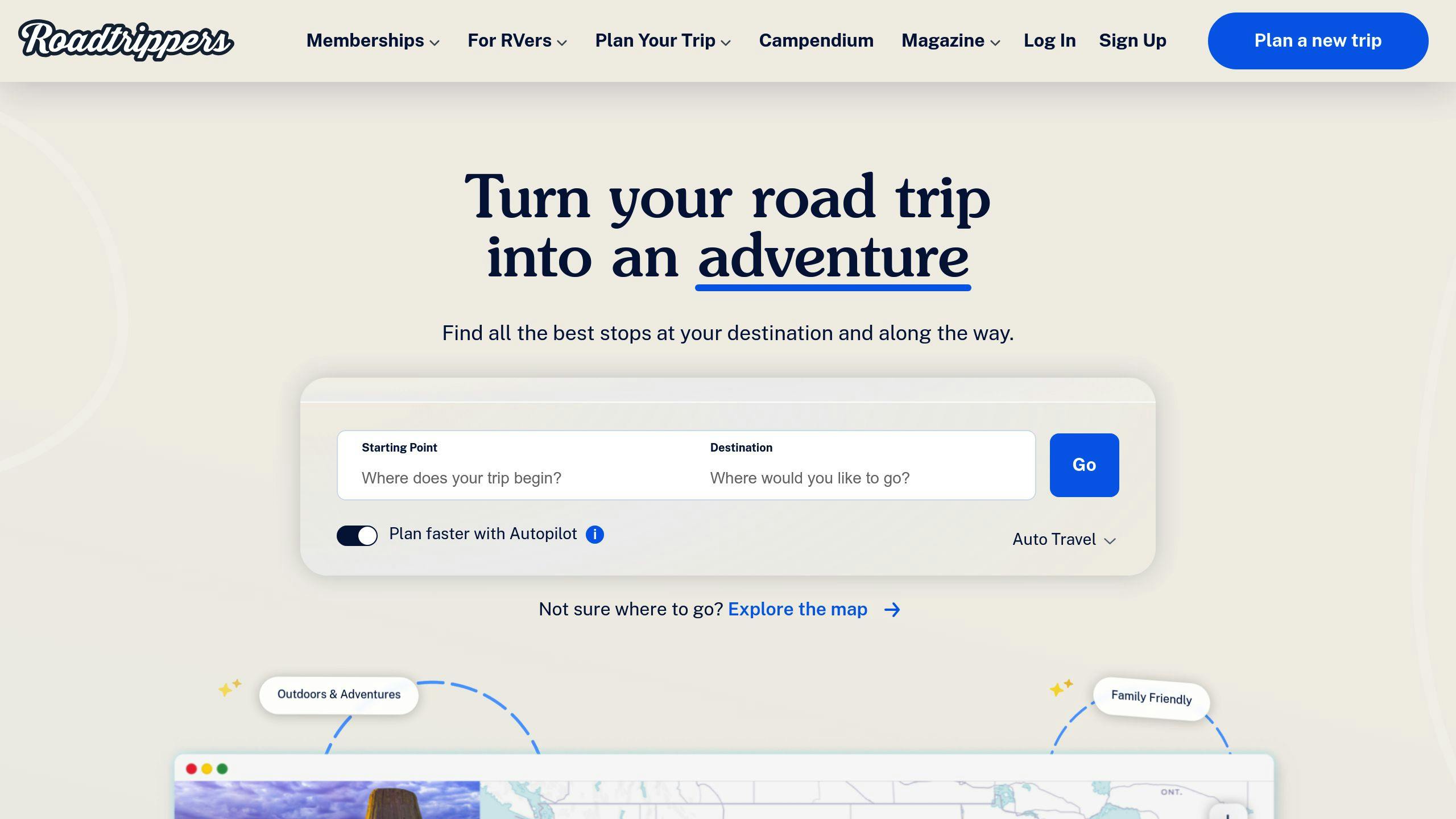
Roadtrippers is a go-to tool for travelers and small businesses planning multi-stop routes. Unlike enterprise-focused platforms like FarEye, it prioritizes travel discovery alongside route planning.
| Feature | Description | Benefit |
|---|---|---|
| Route Optimization | AI-powered sequencing of stops | Cuts down travel time and fuel costs |
| Live Traffic Integration | Real-time traffic updates | Adjusts routes dynamically |
| Destination Database | 150,000+ points of interest | Helps find interesting stops |
| Offline Capabilities | Access to downloaded maps | Works even in areas with no signal |
Roadtrippers pairs real-time traffic updates with a vast database of destinations, making it easy to plan efficient routes while discovering new places. It allows users to customize routes - like avoiding highways or toll roads - and handles itineraries with many stops.
A premium subscription unlocks offline maps and an ad-free experience, ensuring you stay on track even in areas with poor connectivity. Whether on a desktop or mobile app, Roadtrippers offers a smooth, consistent experience for planning and navigating.
That said, it might feel overwhelming for those who only need simple A-to-B navigation. But for anyone looking to create routes with multiple stops and uncover hidden gems along the way, Roadtrippers strikes a great balance between functionality and ease of use.
While Roadtrippers leans towards travel discovery, Badger Maps focuses on business-specific tools designed for field teams.
4. Badger Maps
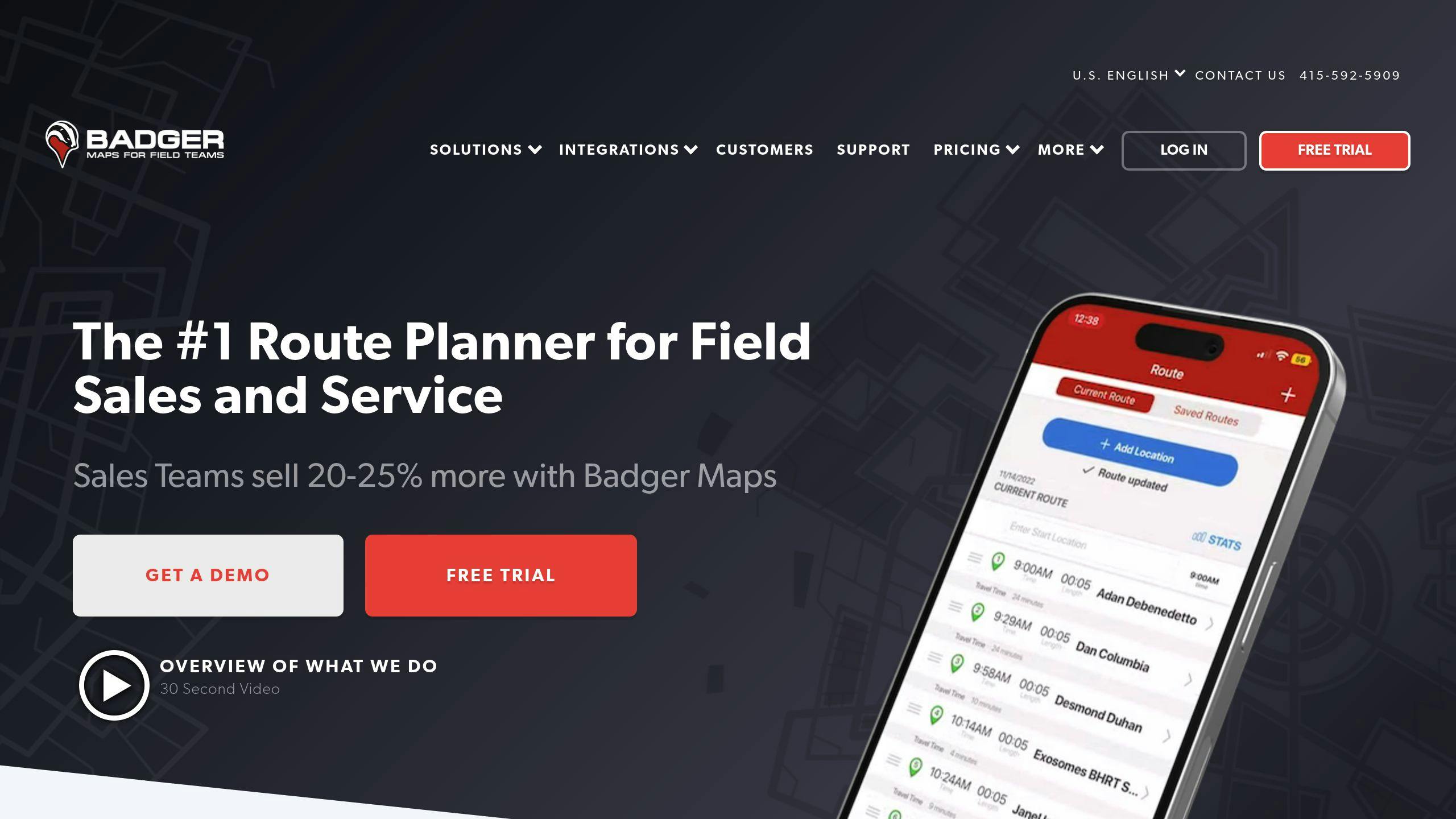
Badger Maps is a route planning tool designed specifically for field sales and service teams. Unlike Roadtrippers, which focuses on travel, Badger Maps prioritizes business efficiency and team coordination.
| Feature | Benefit | Details |
|---|---|---|
| Route Optimization | Cuts drive time by 20% | Uses AI to create faster, optimized routes |
| Team Coordination | Saves 8 hours weekly | Tracks multiple drivers and updates progress |
| Territory Tracking | Improves visibility | Displays live driver locations and coverage |
| Navigation | Easy integration | Routes can be exported to navigation apps |
The platform excels in managing field teams with its AI-powered optimization, which ensures efficient routes and allows for instant adjustments without losing effectiveness. This means teams can adapt quickly to changes while staying on schedule.
One of Badger Maps' standout features is its team collaboration tools. Managers can monitor driver progress and ensure balanced workloads using a single map interface. Real-time territory tracking helps teams cover service areas effectively and avoid overlap.
Users frequently highlight the platform's ability to reduce drive time by 20% and boost sales performance, making it a go-to solution for businesses managing large sales territories. Plus, it integrates smoothly with navigation apps, offering extra flexibility.
For companies with unique logistics needs, alternatives like Trucker Path cater to specific industries, providing tailored solutions beyond field sales and service operations.
5. Trucker Path
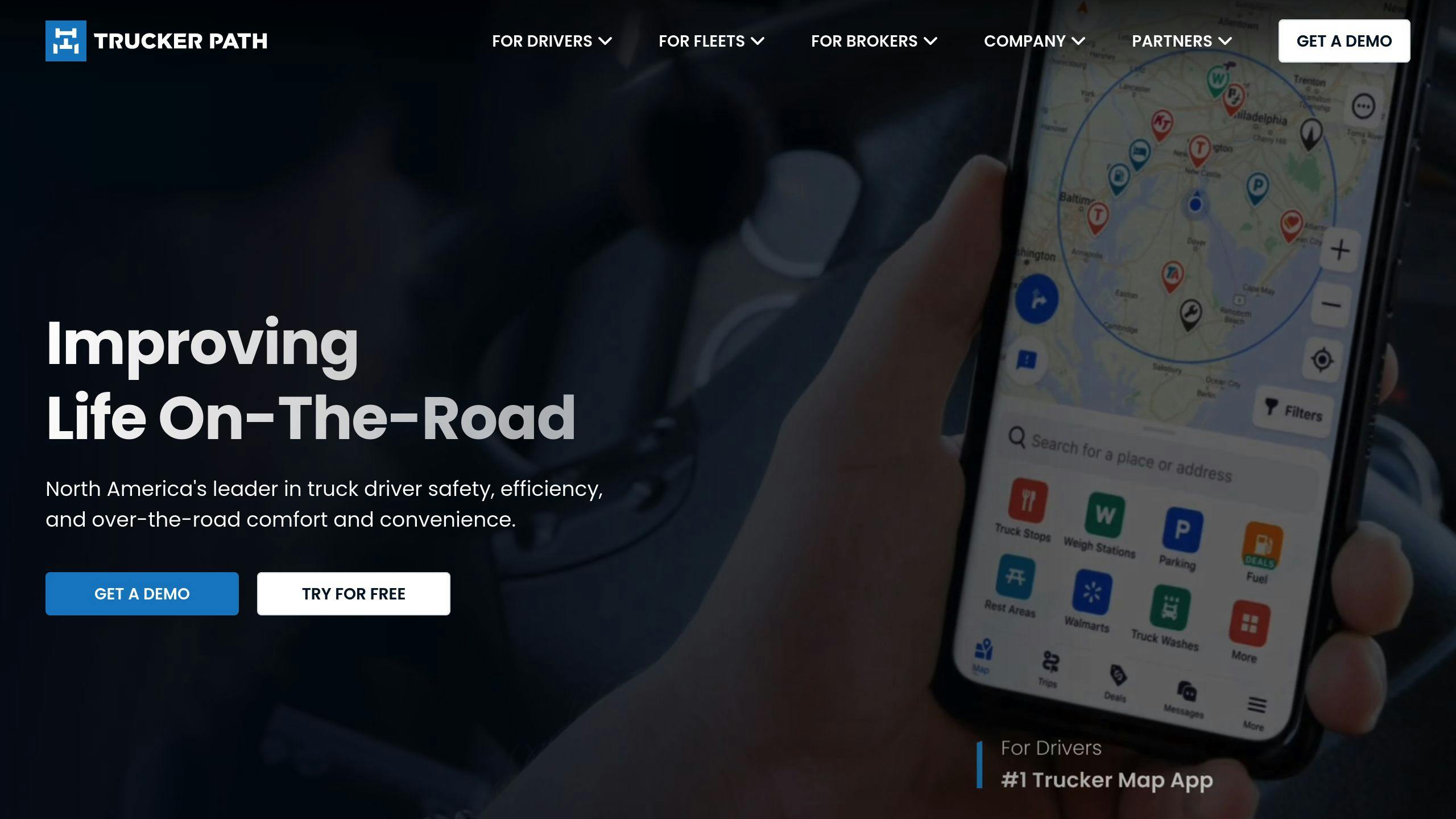
Trucker Path is a navigation and planning tool designed specifically for commercial truck drivers and logistics professionals. It offers features tailored to the unique challenges of trucking, helping streamline fleet operations and improve overall efficiency.
| Feature | Description | Benefit |
|---|---|---|
| Route Optimization | Routes designed for trucks, considering height and weight restrictions | Cuts down on fuel use and travel time |
| Live Traffic Updates | Real-time alerts for congestion and road closures | Helps drivers avoid delays and detours |
| Truck-Specific Data | Includes weigh stations, parking availability, and fuel prices | Supports better decision-making on the road |
| Fleet Management | Route sharing and real-time coordination tools | Enhances fleet productivity |
The app provides essential truck-specific details, such as weigh station locations, parking availability, and fuel price comparisons. These features are often missing from general navigation apps, making Trucker Path a go-to for truckers.
For fleet managers, the premium version includes advanced traffic analysis and detailed truck stop information. Trucker Path works on both iOS and Android devices, ensuring compatibility with a variety of navigation systems used in fleet operations.
One standout feature is its ability to account for truck-specific constraints like height and weight limits - something general mapping tools typically overlook. Combined with live updates and fleet coordination options, Trucker Path is a valuable resource for modern trucking needs.
While Trucker Path caters specifically to the trucking industry, Furkot offers a broader solution for travelers and businesses.
sbb-itb-f962a1b
6. Furkot
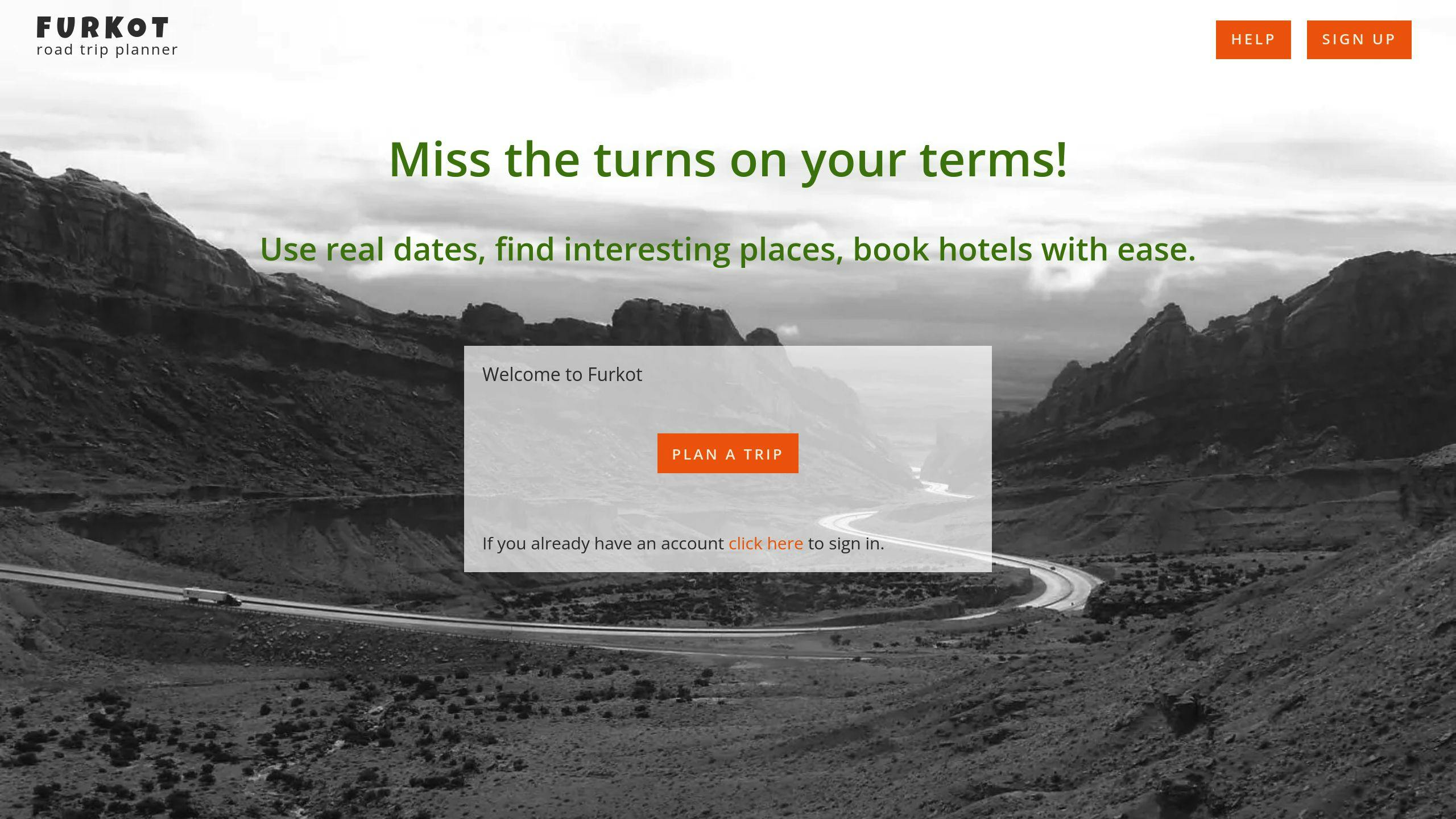
Furkot is a tool designed to help create multi-stop routes that save both time and fuel. Its straightforward design makes it a great pick for travelers and small teams who need to plan trips efficiently.
| Feature | What It Does | Why It Helps |
|---|---|---|
| Route Customization | Adjust stops dynamically | Makes trip planning easier |
| Export Options | Works with navigation apps | Use your favorite tools |
| Collaboration Tools | Share routes with others | Simplifies team planning |
| Trip Organization | Schedule stops by priority | Saves time effectively |
Furkot is perfect for simplifying complex travel plans. Its easy-to-use interface makes it especially handy for field sales teams managing multiple client visits. Instead of overwhelming users with unnecessary features, Furkot focuses on making trip planning smooth and efficient.
You can export routes to your favorite navigation apps and share plans with others for better coordination. However, it does fall short when it comes to real-time traffic updates, which could be a downside during peak travel times. Even so, its strengths in pre-trip organization and route planning make up for this limitation.
For businesses or frequent travelers, Furkot offers a budget-friendly alternative to more specialized route planners. It’s particularly good at organizing trips in advance, taking into account travel time and distances between stops.
While Furkot focuses on pre-trip planning, the next tool steps up with features for real-time navigation and analytics.
7. Apple Maps
Apple Maps has grown into an easy-to-use route planner, supporting up to 15 stops, live traffic updates, and smooth integration with other Apple services. Its straightforward design and sharing features make it a great choice for individuals or small teams.
| Feature | Capability | Benefit |
|---|---|---|
| Stop Capacity | Up to 15 destinations | Ideal for personal and small business routes |
| Traffic Updates | Real-time data | Helps avoid delays and congestion |
| Route Sharing | iOS-friendly sharing | Simplifies group coordination |
| Stop Adjustments | Drag-and-drop editing | Makes it easy to adjust plans |
Apple Maps uses live traffic data to reroute travelers around congestion, accidents, or road closures. It also factors in the time of day and historical traffic trends to recommend efficient routes, making it a reliable tool for daily navigation.
The drag-and-drop interface allows users to quickly add, remove, or rearrange stops. Its built-in sharing feature makes route distribution simple, especially for iOS users, whether you're planning a group trip or organizing small business deliveries.
As a free service, Apple Maps is a budget-friendly option for basic multi-stop planning. However, it lacks some advanced features that more specialized tools offer, such as driver tracking or time window management.
For businesses with more complex needs, these limitations stand out:
- No fleet management tools
- Minimal integration with business software
- Basic route optimization compared to professional platforms
While Apple Maps is a great fit for casual users and small teams, tools like Routific are better suited for businesses with more demanding logistics requirements.
8. Routific
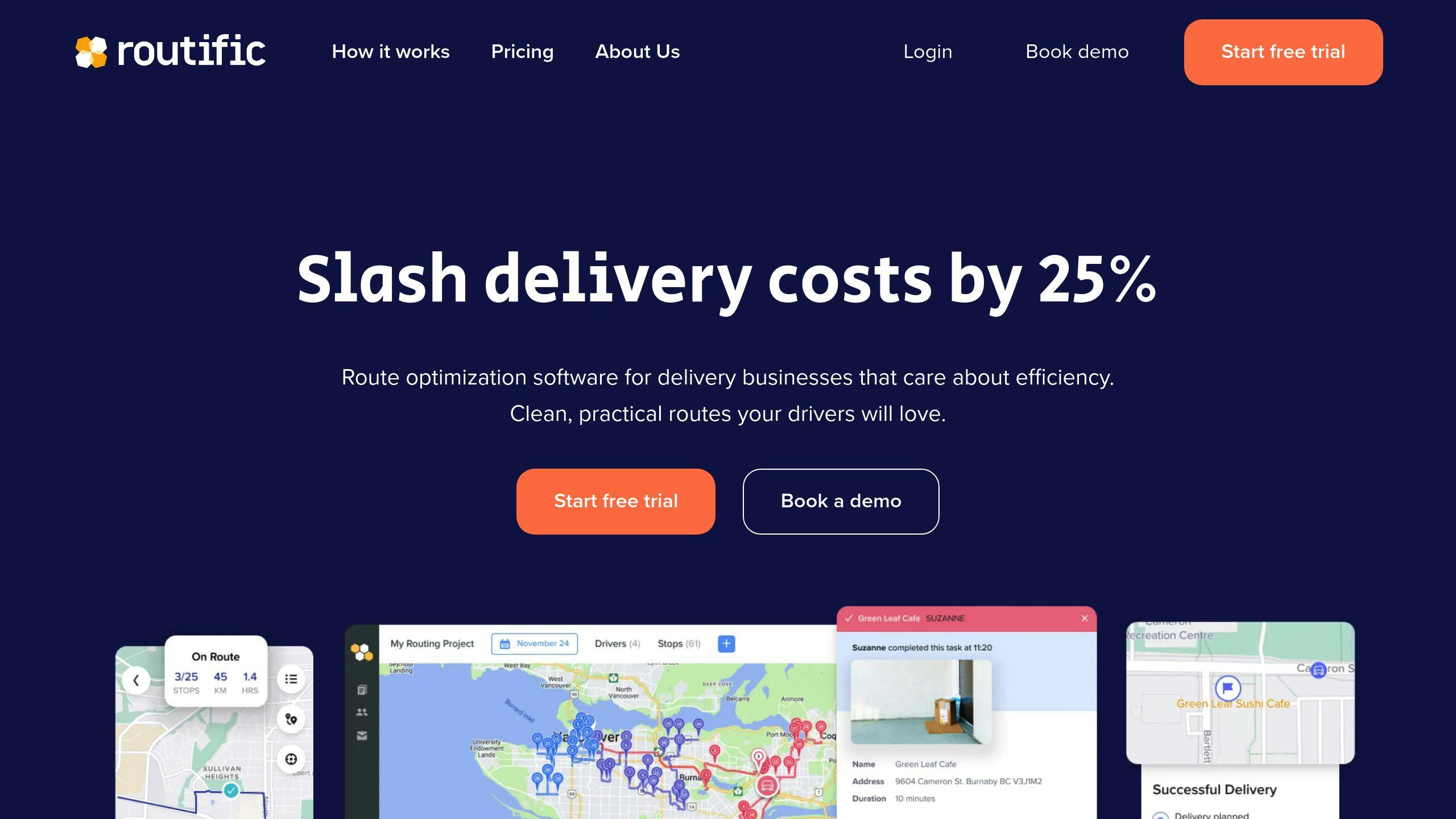
Routific is a route optimization platform tailored for logistics and delivery businesses. It goes beyond basic tools like Apple Maps by offering advanced features designed specifically for managing delivery operations.
| Feature Category | Benefit for Businesses |
|---|---|
| AI-Powered Optimization | Cuts down travel time and fuel costs |
| Real-Time Management | Helps ensure on-time deliveries |
| Business Integration | Simplifies and improves workflows |
What sets Routific apart is its AI-driven route optimization, real-time traffic updates, and flexible delivery scheduling. These tools make it a go-to choice for businesses with detailed logistics needs. By considering real-time traffic, time constraints, and vehicle limits, Routific's optimization engine ensures routes are as efficient as possible, saving both time and fuel.
Unlike basic tools like Apple Maps, Routific adapts to changing conditions by recalculating routes dynamically. It also supports features like time window management, real-time adjustments, and team collaboration, making it a complete solution for delivery operations.
Businesses using Routific have reported lower fuel costs, faster deliveries, and improved punctuality. While its pricing depends on the number of stops and included features, making it better suited for regular business use rather than casual navigation, its comprehensive tools help companies cut logistics costs and improve efficiency.
For businesses handling complex delivery schedules, Routific offers advanced multi-stop planning and management. However, smaller businesses or individuals might find simpler tools like Google Maps more practical for their needs.
9. Google Maps
Google Maps is a popular choice for basic multi-stop route planning, thanks to its wide availability and free access. While it doesn't offer some of the advanced features found in specialized tools, its simple interface and dependable functionality make it a solid option for straightforward routing tasks.
| Feature | Details |
|---|---|
| Maximum Stops | 10 stops per route |
| Real-Time Updates | Live traffic and road condition updates |
| Route Sharing | Yes, including options for team sharing |
| Customization | Basic stop reordering and route adjustments |
| Price | Free |
One of the key strengths of Google Maps is its ability to provide real-time traffic updates and dynamically adjust routes to avoid congestion. Users can easily reorder stops or share routes with others, making it flexible and convenient for coordinating trips.
For individuals or small businesses handling simple delivery routes or planning multi-stop journeys, Google Maps offers practical features like route sharing. This makes it easy to collaborate with team members or travel companions without any added cost.
That said, Google Maps has its limitations when compared to more specialized routing tools. It lacks advanced functionalities such as:
- Managing multiple drivers
- Scheduling based on specific time windows
- Complex route optimization algorithms
- Support for more than 10 stops per route [2]
For users who need these advanced features, tools like RoadWarrior Flex or Routific may be better suited. However, for casual users or small businesses with uncomplicated routing needs, Google Maps provides a dependable and free solution [1][4].
For travelers looking for more versatile tools, platforms like GTFO.co offer creative and multi-functional resources beyond basic routing.
10. GTFO.co
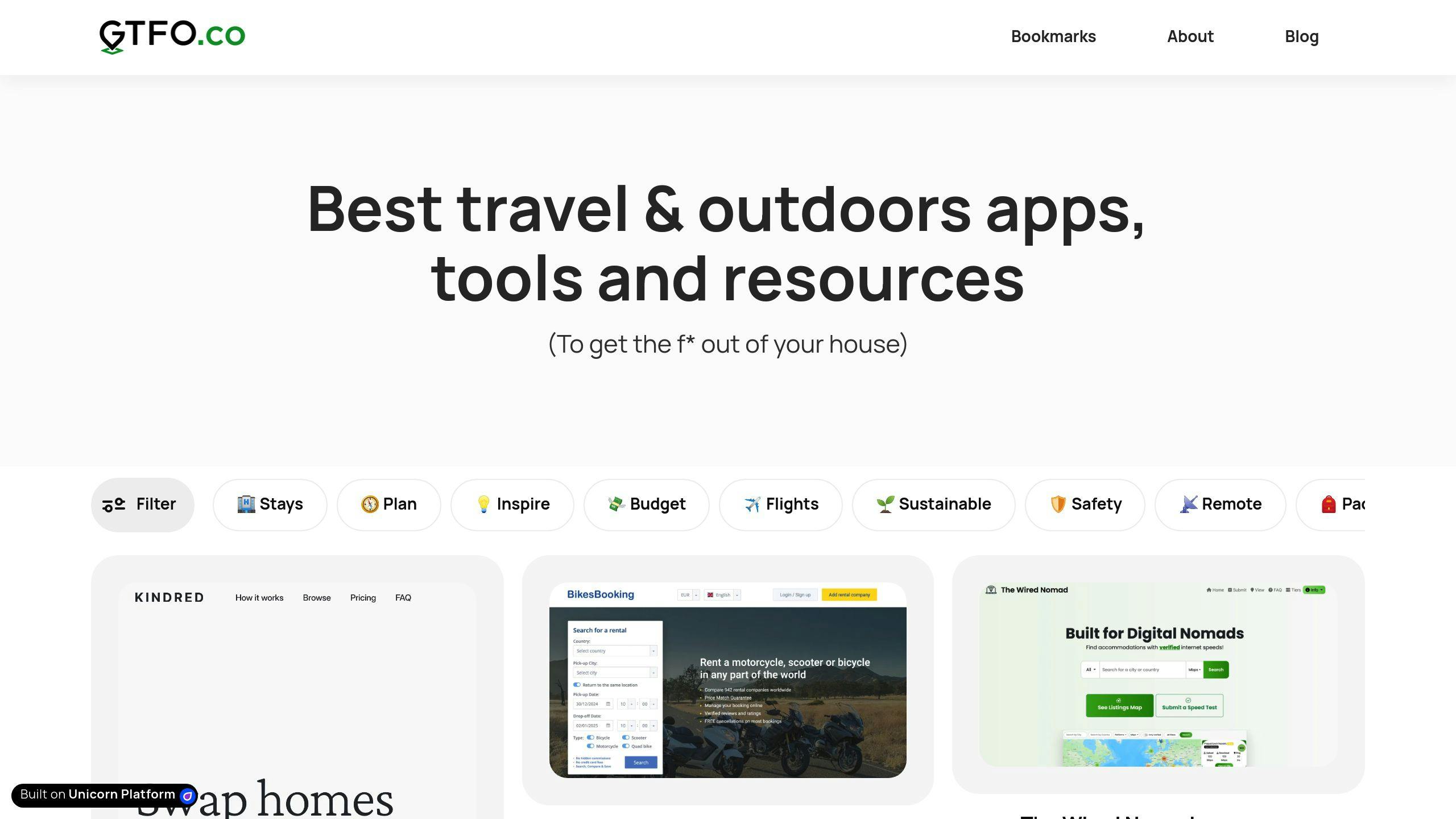
GTFO.co is a directory designed to connect users with travel and navigation tools, such as multi-stop route planners. By carefully reviewing and selecting resources, it simplifies the process of finding reliable solutions for specific routing challenges.
| Feature | Details |
|---|---|
| Primary Function | Helps users discover travel resources |
| Tool Categories | Navigation apps, route planners, maps |
| Vetting Process | Assesses tools for quality and reliability |
| Additional Resources | Travel guides and planning tools |
| Price | Free to access |
GTFO.co simplifies travel planning by offering a curated selection of tools like navigation apps, local tips, and route planners. It connects users with resources tailored to their needs, whether planning a road trip or managing complex delivery routes.
The platform’s focus on quality ensures that every listed tool meets high standards, saving users time and effort. Whether you're a traveler or a business, GTFO.co makes finding the right multi-destination planning tools easy and efficient.
Conclusion
Choosing the right multi-stop route planner in 2025 can make a huge difference in how efficiently your operations run and how much money you save. From our analysis, the key is to clearly define your needs and see how different tools match up to them.
Data backs this up: businesses using tools like RoadWarrior Flex have seen real improvements in route planning and overall productivity [1].
Here are some important factors to keep in mind when comparing your options:
| Factor | Impact | What to Consider |
|---|---|---|
| Operational Efficiency | Daily performance | Stop limits, live updates, route optimization |
| Cost Structure | Budget management | Pay-per-address vs. subscription pricing |
| Integration | Workflow alignment | Compatibility with your current systems |
While Google Maps is a solid, no-cost option, platforms like RoadWarrior Flex and Routific are better suited for businesses with more complex needs. These tools shine when it comes to advanced logistics, scheduling within time windows, and coordinating fleets.
Whether you're managing deliveries, overseeing sales teams on the road, or planning a cross-country trip, the right route planner can turn navigation into a powerful tool for success. By focusing on these factors, you can find a solution that meets your personal or business needs.
FAQs
What is the best multi-stop route planner?
For professional users, RoadWarrior Flex stands out with its advanced route optimization and live traffic updates [1]. For casual users, Apple Maps (up to 15 stops) and Google Maps (up to 10 stops) are good options for basic routing needs [4].
Which map app is best for multiple stops?
Your choice depends on your specific needs:
- Apple Maps: Handles up to 15 stops.
- Google Maps: Free to use but limited to 10 stops.
For specialized purposes:
- Commercial drivers: Trucker Path
- Road trips: Furkot
- Field sales: Badger Maps [4]
What is the best route planner for multiple stops?
The best route planner varies based on your usage. Here's a quick breakdown:
| User Type | Recommended Planner | Key Feature |
|---|---|---|
| Field Sales | Badger Maps | Route optimization |
| Truckers | Trucker Path | Industry-specific tools |
| Travelers | Furkot | Trip planning |
| Daily Use | Apple Maps | Easy to use |
Is there a map app that allows multiple destinations?
Both Google Maps and Apple Maps offer free multi-stop routing but with limits. For those needing unlimited stops and advanced features, premium apps like Upper, Route4Me, and Speedy Route are worth exploring [4].
What is the best app to create a route with multiple stops?
For business users, Badger Maps is a top choice, delivering proven efficiency improvements [4]. Casual users can rely on Apple Maps or Google Maps, while professionals needing advanced tools should look into RoadWarrior Flex or Routific.
For more insights into each tool's features, check the detailed reviews mentioned earlier.


